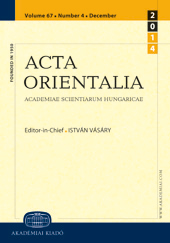Two Tocharian borrowings of oriental origin
Two Tocharian borrowings of oriental origin
Author(s): Krzysztof Tomasz WitczakSubject(s): Theoretical Linguistics, Semantics, Historical Linguistics, Comparative Linguistics, Philology
Published by: Akadémiai Kiadó
Keywords: historical-comparative linguistics; Tocharian languages; animal names; oriental borrowings; Turkic languages; Iranian languages; semantic change;
Summary/Abstract: The present paper examines the origin of two Tocharian animal names, assuming that they were borrowed from an oriental source. The Common Tocharian term for ‘poisonous snake, viper’ (Toch. A ārṣal, B arṣāklo) reproduces exactly the Turkic name *arsala:n ‘lion’, whereas the Tocharian B partākto ‘camel’ seems to represent a loanword from East Iranian *pardāk(u)-tā (pl.) ‘leopards’ (perhaps created by a contamination with Altaic *aktan- ‘a castrated animal’). The phonetic aspects of both derivations are unquestionable. The semantic differences may be explained by the fact that Proto-Tocharians borrowed names of two unknown exotic animals and later they wrongly identified the word with different animals, transferring the Turkish name for ‘lion’ into ‘poisonous snake, viper’ and the Iranian name for ‘leopard’ into ‘camel’. The same process is perfectly attested in Slavonic (e.g. Polish słoń ‘elephant’ < Turkish (dial.) aslan ‘lion’; Pol. wielbłąd ‘camel’ < Greek elephas, -antos ‘elephant’) and many other languages.
Journal: Acta Orientalia Academiae Scientiarum Hungaricae
- Issue Year: 66/2013
- Issue No: 4
- Page Range: 411-416
- Page Count: 6
- Language: English
- Content File-PDF

